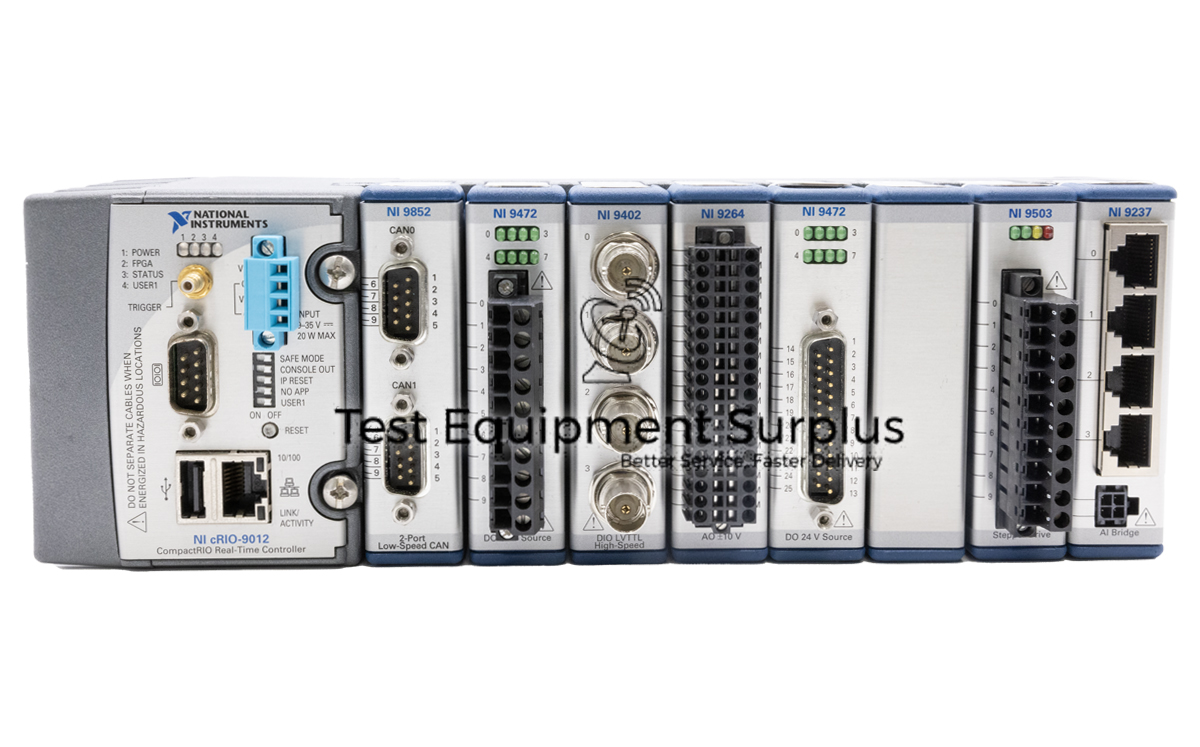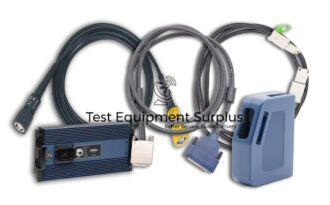Description
The National Instruments cRIO-9101 CompactRIO Chassis, with its Part Number 779052-01, is a versatile 4-slot platform designed for modular expansion and integration into various industrial applications. It boasts an FPGA with 5120 logic slices and 81,920 bytes of embedded RAM, offering robust processing and control capabilities.
Communication with the cRIO-9101 necessitates a CompactRIO Controller to manage the data flow to and from the installed I/O modules. For those requiring a DIN rail mount, the optional National Instruments 9912 DIN rail kit is available, alongside other mounting options such as rack mounting and panel mounting, which provides flexibility in installation.
The chassis is lightweight, weighing approximately 490 grams, and operates efficiently with a maximum power requirement of 2,300 mW, drawing 500 mW from a +5 VDC power supply and 1,800 mW from a +3.3 VDC rail. Compatibility with a Windows computer equipped with NI-RIO drivers is necessary for the software interface.
Additionally, the cRIO-9101 features the capacity for individual connections of I/O modules to the FPGA, enabling high-speed performance and synchronization with a resolution of up to 25 nanoseconds. The hot-swappable nature of the I/O modules ensures that system upgrades or maintenance can occur without interrupting the entire control system’s operation.
| Specification | Detail |
|---|---|
| Product | National Instruments cRIO-9101 CompactRIO Chassis |
| Part Number | 779052-01 |
| Number of Slots | 4-Slot |
| Logic Slices in FPGA | 5120 |
| Embedded RAM in FPGA | 81,920 bytes |
| Communication | Requires CompactRIO Controller |
| DIN Rail Kit (Optional) | National Instruments 9912 |
| Mounting Options | DIN rail, Rack mounting, Panel mounting |
| Weight | Approximately 490 g |
| Power Requirements (+5 VDC) | 500 mW |
| Power Requirements (+3.3 VDC) | 1,800 mW |
| Total Power Required (Maximum) | 2,300 mW |
| Software Compatibility | Windows computer with NI-RIO drivers |
| I/O Modules | Individual connection to FPGA, Hot-swappable |
| Synchronization Resolution | Up to 25 ns |
Question 1: What are the power requirements and connection capabilities of the National Instruments cRIO-9101 CompactRIO Chassis for industrial applications?
Answer 1: The individual connections of I/O modules to the FPGA in the National Instruments cRIO-9101 chassis enable direct communication with the FPGA, which allows for high-speed performance and precise synchronization with a resolution of up to 25 nanoseconds, ensuring efficient and accurate data handling for industrial applications.
Question 2: How do the individual connections of I/O modules to the FPGA in the National Instruments cRIO-9101 chassis contribute to its high-speed performance and synchronization capabilities?
Answer 2: The National Instruments cRIO-9101 CompactRIO Chassis requires a maximum power of 2,300 mW, drawing 500 mW from a +5 VDC power supply and 1,800 mW from a +3.3 VDC rail, weighs approximately 490 grams, and features individual connections of I/O modules to the FPGA for high-speed performance and synchronization with up to 25 nanoseconds resolution.
Question 3: What are the power supply requirements and weight of the National Instruments cRIO-9101 CompactRIO Chassis, and what additional feature allows for high-speed performance and synchronization of I/O modules?
Answer 3: The National Instruments cRIO-9101 CompactRIO Chassis requires a maximum power of 2,300 mW, drawing 500 mW from a +5 VDC power supply and 1,800 mW from a +3.3 VDC rail, and offers several installation options including an optional DIN rail kit (National Instruments 9912), rack mounting, and panel mounting; these power-efficient and flexible mounting solutions contribute to its adaptability by allowing easy integration into various industrial
Question 4: What are the FPGA resources and maximum power requirement of the National Instruments cRIO-9101 CompactRIO Chassis, including the specific voltages it draws power from?
Answer 4: The National Instruments cRIO-9101 CompactRIO Chassis is equipped with an FPGA that contains 5120 logic slices and 81,920 bytes of embedded RAM, and it has a maximum power requirement of 2,300 mW, drawing 500 mW from a +5 VDC power supply and 1,800 mW from a +3.3 VDC rail.
Question 5: What are the power specifications and installation options available for the National Instruments cRIO-9101 CompactRIO Chassis, and how do these features contribute to its adaptability in industrial settings?
Answer 5: The National Instruments cRIO-9101 CompactRIO Chassis requires a maximum power of 2,300 mW, with 500 mW drawn from a +5 VDC power supply and 1,800 mW from a +3.3 VDC rail, and it offers individual connections of I/O modules to the FPGA for high-speed performance and synchronization, necessitating a CompactRIO Controller for communication within industrial applications.



